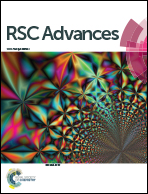Bioinspired amphiphilic phosphate block copolymers as non-fluoride materials to prevent dental erosion†
Abstract
Inspired by the fact that certain natural proteins, e.g. casein phosphopeptide or amelogenin, are able to prevent tooth erosion (mineral loss) and to enhance tooth remineralization, a synthetic amphiphilic diblock copolymer, containing a hydrophilic methacryloyloxyethyl phosphate block (MOEP) and a hydrophobic methyl methacrylate block (MMA), was designed as a novel non-fluoride agent to help prevent tooth erosion under acidic conditions. The structure of the polymer, synthesized by reversible addition–fragmentation chain transfer (RAFT) polymerization, was confirmed by gel permeation chromatography (GPC), Fourier transform infrared spectroscopy (FTIR), and nuclear magnetic resonance spectroscopy (NMR). While the hydrophilic PMOEP block within the amphiphilic block copolymer strongly binds to the enamel surface, the PMMA block forms a hydrophobic shell to prevent acid attack on tooth enamel, thus preventing/reducing acid erosion. The polymer treatment not only effectively decreased the mineral loss of hydroxyapatite (HAP) by 36–46% compared to the untreated control, but also protected the surface morphology of the enamel specimen following exposure to acid. Additionally, experimental results confirmed that low pH values and high polymer concentrations facilitate polymer binding. Thus, the preliminary data suggests that this new amphiphilic diblock copolymer has the potential to be used as a non-fluoride ingredient for mouth-rinse or toothpaste to prevent/reduce tooth erosion.


 Please wait while we load your content...
Please wait while we load your content...